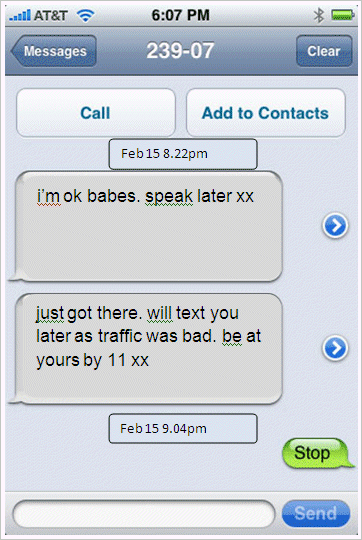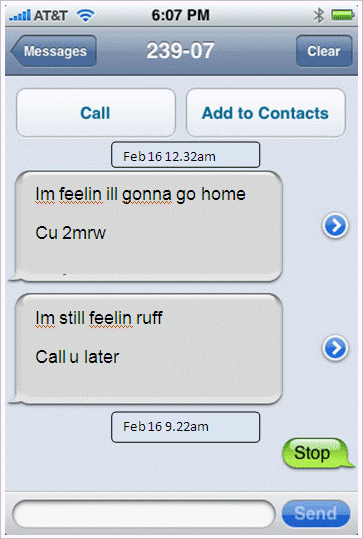Forensic linguistics: a starter
Forensic linguistics is a growing area of language study that combines the analysis of language with solving crimes. All of us use language in subtly (and sometimes not very subtly) different ways – so when we write or speak, we leave clues that sharp-eyed language detectives can pick up.
In this resource, we take a quick look at the kinds of clues forensic linguists look for when they try to work out the identity of a writer.
Some time over the evening of February 15th and morning of February 16th, Melinda Butler disappeared. She was last seen in a bar in Reading soon after 9 pm on the 15th and was expected to arrive at her boyfriend’s house that night. She didn’t arrive, but he received two texts the next day – one soon after midnight and one some time after 9 am – saying that Melinda was ill and had gone home.
When police checked her flat, she wasn’t there. A day later she still hadn’t been tracked down.
Below you can see two sets of text messages. One set is from Melinda on February 15th and the other set was received on the 16th. The forensic linguists brought on to the case don’t believe the second set are actually from Melinda. What language evidence can you find to suggest that the senders of the two sets of text messages are not the same person?
Try to pick out five separate language features that you think point to two different people sending the texts.
Data set 1 – February 15th

Data set 2 – February 16th

For suggested answers, see the next resource page.
Welcome!

Englicious is totally free for everyone to use!
But in exchange, we ask that you register for an account on our site.
If you’ve already registered, you can log in straight away.
Since this is your first visit today, you can see this page by clicking the button below.
Forensic linguistics: some answers
So, what clues did you find? The police were convinced that the two sets of messages were actually from different people, and that Melinda hadn’t sent the messages on February 16th, but they needed evidence.
Some of the clues in the data are easier to spot than others, but here are some differences:
Data set 1
- Signed off with xx.
- Punctuated as sentences with full stops.
- No sentences begin with capital letters: always lower case.
- Subject ellipsis used in 4 out of 5 sentences.
- No abbreviations or deviant spellings.
- Uses one complex sentence.
Data set 2
- No sign-off.
- Sentence punctuation not used consistently.
- Sentences start with capital letters.
- Uses abbreviations and deviant spellings.
- Misses out apostrophes on contractions.
- All simple sentences.
Forensic linguistics: how is it done?
Forensic linguistics often uses a form of language analysis known as stylistics. In the past, stylistics was largely used to study the language styles of literature texts, but when used as part of forensic stylistics it is applied to all sorts of language, from letters, text messages and audio recordings of police interviews, through to suicide notes and ransom demands.
To understand a bit more about forensic stylistics we have to think about the things that we say and write that mark us out as different. We are all likely to have features in our language styles that are linked to where we are from, what kinds of jobs we work in or places we study in, and the social groups we are part of or choose to identify with.
So a teenager who is from south Wales and rides BMX bikes and listens to indie rock in his spare time will have a range of different language features from a fifty-year-old dentist from Croydon who likes to build model aeroplanes and discuss medieval history in her spare time.
Gerald Mcmenamin, a forensic linguist, points out that despite these differences in region, lifestyle, gender and age, most people ‘conform to the norm of the group they are part of’ but talks about factors that might cause ‘individual divergence from the norm’ (in other words, reasons for individual differences between people with similar backgrounds).
To cut a long story short, we are all different in some way and our language will reflect this in important ways.
Forensic linguistics involves studying these individual characteristics to reach conclusions about authorship and/or consistency. Authorship tasks help to ‘exclude or identify just one of a few suspect writers’ based on the resemblance of a piece of known language to a piece of questioned language.
For example, if you want to work out whether the person who wrote a threatening letter to a newspaper is the same person whose letters you have in your possession, you would carry out a resemblance test, checking the language of the questioned item (the threatening letter) against the language of the known items (letters you have collected and know to have been written by person X). If they didn’t match, you would need to collect known items from other potential suspects and carry out resemblance tests on them too.
Another use of forensic linguistics is to test consistency and work out if ‘various writings were written by the same author’ (op cit). For example, if there is doubt over the veracity of a will drawn up by an elderly relative, a consistency model might be applied and the language style of known items written by the person compared to the style of the questioned item. The idea is to work out if the questioned item is consistent with the known items, or possibly written by someone else.
In several criminal cases it has been discovered that wills have had extra paragraphs added to them by unscrupulous relatives so that they would profit. In other cases, police officers have added incriminating content to suspects’ statements in order to secure a conviction.
In forensic linguistics, a mixture of qualitative and quantitative analysis can be carried out. Quantitative studies measure numbers. In its simplest form, this might mean counting up the number of times a particular feature like a spelling error appears in one person’s writing and comparing that total to the number of times the same error appears in another person’s writing. At a more complicated level, this can involve crunching large amounts of data and working out detailed statistics which help to reveal the likelihood of one person having written a document.
Qualitative methods focus less on counting numbers and more on describing and explaining features, and it is this that we’ll look at in more detail here.
What are forensic linguists looking for?
Many of the style markers that forensic linguists are looking for are quite small details of language, but they’re not very hard to spot.
Spelling patterns
Some English homophones (words that sound basically the same) have different spellings that people easily confuse:
| there | their | they’re |
| your | you’re | |
| then | than | |
| should have | should’ve | should of |
| take off | take of | |
| write | right |
Punctuation patterns
Some people place commas and full stops right next to the words they follow and others put them a space away (compare thanks, with thanks , ).
Errors with punctuation can be spotted too, such as using apostrophes with plurals when they aren’t required (e.g. he took the dog’s to the park).
Other potential patterns concern the use of single or double inverted commas, or brackets. Forensic linguists have detected patterns in their use around names or apparently random words, for instance.
Grammar patterns
In English there are a number of ways in which the same idea can be expressed. Take this sentence, for example: I sang her the song. This could equally be written as I sang the song to her.
Patterns of Subject–verb agreement are often a feature of non-standard varieties of English, so if Subjects and verbs do not match up they may provide a clue: for example, we was or she were.
Discourse features
Beyond the words and grammar patterns of a text, the discourse features of a piece of writing can often give us clues about an author’s style. One area worth looking at is how a letter uses a salutation (e.g. Dear X, Hi X, or Hi, X) or sign-off (e.g. Yours, Cheers, Bye, or With Best Wishes).
Forensic linguistics as a field covers more than we have time and space to look at here. If you are interested in finding out more, have a look at the website of the Centre for Forensic Linguistics at Aston University.